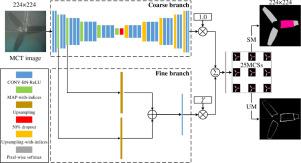Computers & Electrical Engineering ( IF 4.3 ) Pub Date : 2021-06-10 , DOI: 10.1016/j.compeleceng.2021.107182 Haiyang Peng , Dingding Yang , Tianzhen Wang , Shreya Pandey , Lisu Chen , Ming Shi , Demba Diallo

|
Microorganisms attached to marine current turbine may induce imbalance faults that badly affect the power generation efficiency. Therefore, it is necessary to conduct attachment recognition for prompt device maintenance. This paper proposes a coarse-fine semantic segmentation network (CSSN) to adaptively recognize the attachment location and size from blurry underwater images. The CSSN contains a deep coarse branch to perform global segmentation and a shallow fine branch to obtain local contours. The two branches are adaptively fused with dynamic weights in the training process. The final segmentation maps are produced by a softmax layer, after which the precise attachment area percentage can be computed. Besides, dropout is applied to estimate the recognition uncertainty that provides intuitive guidance for the maintenance decision. Experimental results show that the proposed method is efficient to recognize the attachment under turbid submerged conditions.
中文翻译:

一种自适应粗细语义分割的海流涡轮机附件识别方法
附着在海流涡轮机上的微生物可能会导致严重影响发电效率的不平衡故障。因此,有必要进行附件识别,以便及时进行设备维护。本文提出了一种粗细语义分割网络(CSSN)来自适应地从模糊的水下图像中识别附件位置和大小。CSSN 包含一个用于执行全局分割的深粗分支和一个用于获取局部轮廓的浅细分支。这两个分支在训练过程中自适应地与动态权重融合。最终的分割图由 softmax 层生成,之后可以计算精确的附着面积百分比。此外,使用dropout来估计识别不确定性,为维护决策提供直观的指导。


























 京公网安备 11010802027423号
京公网安备 11010802027423号